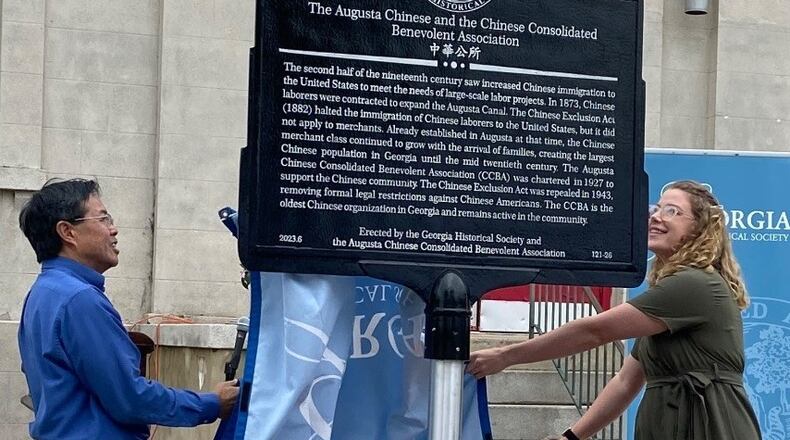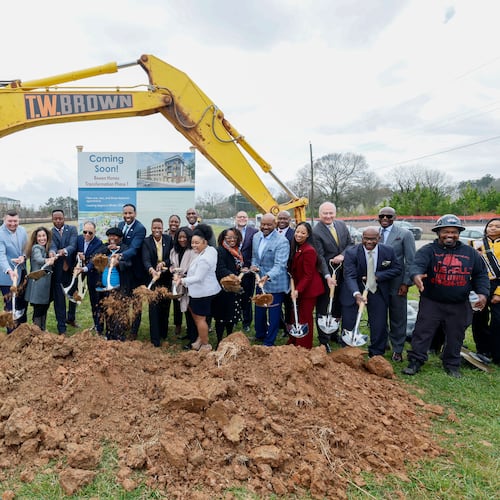Gary Tom was born and raised in Augusta.
His grandfather, a native of China, moved to the east central Georgia city in 1927 and opened a grocery store in the Black community. Tom’s father later took over the business but closed the store after opening a restaurant in 1976.
Tom remembers the days when walking through downtown Augusta meant seeing the limitations of Jim Crow that were placed on people of color. He and other residents of Asian descent knew that while they may have enjoyed some privileges that Black residents did not enjoy, such as attending school with white students, they still had to carefully toe the line of segregation.
“Outside of the Black community, people didn’t realize there was a Chinese community here,” said Tom, 69, when we talked by phone. “We kept a low profile.”
Last month, the hidden history of Augusta’s Chinese community was shared in a historic marker, the first Georgia Historical Society (GHS) marker to focus on Asian American and Pacific Islander history in the state, according to GHS.
Located on Walker Street in downtown Augusta in front of the Chinese Consolidated Benevolent Association (CCBA), the marker describes the story of the Chinese community in Augusta, including the creation of the CCBA, the oldest Chinese organization in Georgia.
“We had our own buildings and functions. It was a place for kids and families to help them socialize,” Tom said. The CCBA helped create a special bond among Chinese residents who came to Augusta in the early 1900s. “I want to honor those families and preserve a legacy,” said Tom, who applied to have the marker erected.
Today, almost 415,000 Asian individuals live in Georgia and comprise 4% of the state’s population based on data from Atlanta Regional Commission. Almost 15% of those who identify as Asian in Georgia are Chinese, but it wasn’t until after the passage of the Civil Rights Act that metro Atlanta supplanted Augusta as the area with the greatest population of Asian residents.
Georgia’s earliest Asian residents were indentured workers hired to tend plantations after slavery was abolished at the end of the Civil War. In 1873, the City of Augusta hired 200 Chinese laborers to expand the Augusta Canal.
Credit: Gary tom
Credit: Gary tom
When it was completed, some Chinese left but others stayed behind and formed a community, Tom said. While immigration of Chinese laborers was slowed by the Chinese Exclusion Act of 1882, the merchant class in Augusta flourished, largely providing services in Black communities where white merchants did not want to do business.
In the 1880 census, there were only 20 Chinese residents in Georgia, Tom said, and at least a dozen of them lived in Augusta. After World War II, Chinese families in Augusta began to move beyond the borders of the Black community and become more visible, Tom said.
But even among residents of Augusta, much of this history wasn’t known, Tom said.
Because of the historical marker, the CCBA was inspired to also create a historical photo exhibit. “We went back and got as many of the photographs of some of the early families as we could and put together 40 to 50 panels of families and events,” Tom said.
The exhibit was on display at local libraries and Tom said they want to digitize it so it can be viewed by a broader audience.
“I think it is very important that the public knows our story and knows our contributions to the community,” he said.
The effort of just a few people is sometimes all that is needed to make sure history is preserved and shared.
Beginning June 19 (Juneteenth), I’ll be documenting how Black history is being preserved in the southeast during a weeklong road trip with my 12-year-old daughter to visit Black history museums across Georgia, Alabama and South Carolina. (You can follow our journey at https://www.ajc.com/opinion/real-life-blog/ and https://www.instagram.com/ajcnews/).
Some of the institutions we are visiting, such as the International African American Museum in Charleston, are massive multimillion dollar projects that involved several entities to bring the museums to fruition. Others, including the Africatown Heritage House in Mobile, are smaller efforts designed as much for the individuals who are part of history as for those who may be coming to learn about it.
Not unlike the historical marker or the photo exhibit created by the Chinese community in Augusta, these spaces began with the desire of an individual or individuals to tell their stories, see themselves and their families represented in the history and development of our country, link the past to the present through ancestral connections, and share those experiences with others.
Read more on the Real Life blog (www.ajc.com/opinion/real-life-blog/) and find Nedra on Facebook (www.facebook.com/AJCRealLifeColumn) and Twitter (@nrhoneajc) or email her at nedra.rhone@ajc.com.
About the Author
Keep Reading
The Latest
Featured





